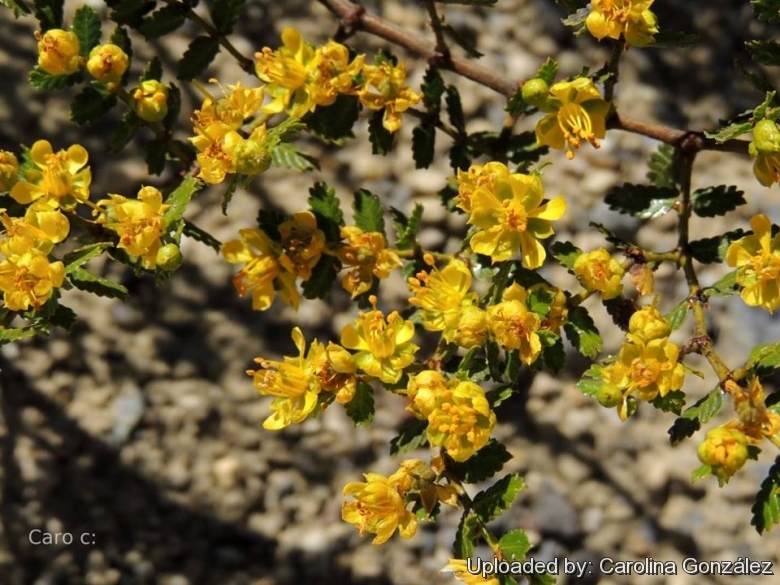




Your support is critical to our success.

Origin and Habitat: Larrea nitida is abundant in northern Patagonia, Territory of Salta, Neuquen, Chubut, and the southern Monte. It is not found in the valley of the Rio Negro, but on the outer slopes of the Andes above the junction of the rivers Limay and Nenquen. It extends northward to the outer slopes of the Andes both on the eastern and western sides to about S. lat. 30°.
Altitude range: Larrea nitida lives at higher altitudes than Larrea cuneifolia and Larrea divaricata (between 1500 and 3000 metres above sea level), overlapping only partially the altitudinal distribution of the latter.
Habitat and ecology: This species grows on dry sandy loam or sandy-clay soils. Several wild bees species uses L. nitida as a pollen source.
Synonyms:
- Larrea nitida Cav.
Larrea nitida Cav.
Anales Hist. Nat. 2(4): 120–122, pl. 18 1800.
Synonymy: 2
- Larrea nitida Cav.
- Larrea balsamica (Molina) I.M.Johnst.
ENGLISH: Shining leaved larrea, Creosote Bush, Greaseweed
ITALIAN (Italiano): Larrea lustra
SPANISH (Español): Jarilla de la Sierra, Jarilla crespa, Jarilla, Jarilla de río, Jarilla hembra
Description: Larrea nitidaSN|32163]]SN|32163]], or shining leaved larrea, is a shrub or small knotty and very much branched tree. The whole plant exudes a copious glutinous resin of a strong scent. Larrea nitida is similar to Larrea cuneifolia, but with more shining leaves due to the abundant resins content and generally not as high: 0.5-1 m (2 or more metres in sheltered places). The blossoms are small yellow and grow on the leaf axil. Larrea nitidaSN|32163]]SN|32163]] was described by Antonio José Cavanilles and published in Anales de Historia Natural 2(4): 120–122, pl. 18. 1800.
Derivation of specific name: nitidus,-a,-um; from Latin epithet nitidus (from L. nitere, to shine), meaning “bright, shining” by extension also brilliant, gracefull, for the shining resinous exudate of twigs end leaves.
Stem: Wood very hard, clothed with fine, viscous, short down, very resinous, burning with a bright flame, dense smoke, and acrid odour. The branches are round rather zig-zag, repeatedly subdivided spreading, rough and viscid.
Leaves The secondary branches bear (4-)5-7(-8) pairs of leaflets, that are opposite, sessile, apparently regarded as forming a pinnate leaf, crowded, two ranked, very regularly disposed, coriaceous, oblique, oblong, entire, twice as long as broad about 7-13 mm in length shining glutinous of which the two uppermost are unequal and very small looking as if there were an odd one at the end. Stipules 2 very short reddish.
Flowers: Axillary, solitary, alternate, with 5 petals and 5 overlapping sepals, deep yellow. Stamens numerous, long and yellow. Ovary hairy. The flowers and fruit are borne on roughish pedicels (stalks) shorter than the leaves.
Blooming season: Flowering in April
Fruit (capsules): Globose, with 5 indeishent, separable mericarps. Its outer coat is yellowish, naked or clothed with fine short grey-white down, coriaceous and rugged.
Seeds: Nuts without valves or sutures
Bibliography: Major references and further lectures
1) John Wilkes “Encyclopaedia Londinensis”, Volume 12 1814
2) V. Batelli, “Dizionario delle scienze naturali nel quale si tratta metodicamente dei differenti esseri della natura, considerati o in loro stessi, secondo lo stato attuale delle nostre cognizioni, o relativamente all'utilità che ne può risultare per la medicina, l'agricoltura, il commercio, e le arti: Accompagnato da una biografia de' più celebri naturalisti” 1844
3) William Berryman Scott “Reports of the Princeton University Expeditions to Patagonia, 1896-1899: J. B. Hatcher in Charge”, Volume 8 The University, 1915
4) Marticorena, C. & M. Quezada. “Catálogo de la Flora Vascular de Chile”. Gayana, Bot. 42: 1–157. 1985.
5) Zuloaga, F. O., O. Morrone, M. J. Belgrano, C. Marticorena & E. Marchesi. (eds.) “Catálogo de las plantas vasculares del Cono Sur”. Monogr. Syst. Bot. Missouri Bot. Gard. 107(1–3): i–xcvi, 1–3348. 2008.
6) Kiesling. R. 2003. “Flora de San Juan. República Argentina”. Volumen II. Estudio Sigma.
7) Sistema de Información de Biodiversidad. “Larrea nitida” <http://www.sib.gov.ar/ficha/PLANTAE*larrea*nitida> web 30 December 2015.
8) Colaboradores de Wikipedia, “Larrea nitida”, Wikipedia, La enciclopedia libre, 22 junio 2015, 07:58 UTC, <https://es.wikipedia.org/w/index.php?title=Larrea_nitida&oldid=83343068> [descargado 30 diciembre 2015]
9) Jimena Dorado, Diego P. Vazquez, ́Erica L. Stevani, & Natacha P. Chacoff “Rareness and specialization in plant–pollinator networks” in Ecology, 92(1), 2011, pp. 19–25, 2011 by the Ecological Society of America
Cultivation and Propagation: Not cultivated. It has many medicinal properties.
| Your Actions | |
|---|---|
| Back to Larrea index | |
| Back to Zygophyllaceae index | |
 |
Back to Trees Encyclopedia index |
Privacy stantement - Terms and conditions - How to cite - About us - Feedback - Donate


